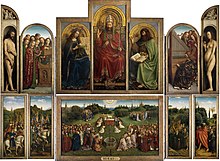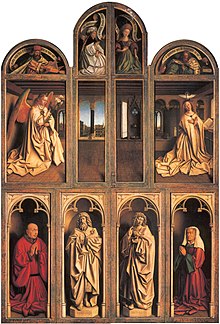
A diptych is any object with two flat plates which form a pair, often attached by hinge. For example, the standard notebook and school exercise book of the ancient world was a diptych consisting of a pair of such plates that contained a recessed space filled with wax. Writing was accomplished by scratching the wax surface with a stylus. When the notes were no longer needed, the wax could be slightly heated and then smoothed to allow reuse. Ordinary versions had wooden frames, but more luxurious diptychs were crafted with more expensive materials.
Hans Memling was a painter active in Flanders, who worked in the tradition of Early Netherlandish painting. Born in the Middle Rhine region, he probably spent his childhood in Mainz. During his apprenticeship as a painter he moved to the Netherlands and spent time in the Brussels workshop of Rogier van der Weyden. In 1465 he was made a citizen of Bruges, where he became one of the leading artists and the master of a large workshop. A tax document from 1480 lists him among the wealthiest citizens. Memling's religious works often incorporated donor portraits of the clergymen, aristocrats, and burghers who were his patrons. These portraits built upon the styles which Memling learned in his youth.

An altarpiece is an artwork such as a painting, sculpture or relief representing a religious subject made for placing at the back of or behind the altar of a Christian church. Though most commonly used for a single work of art such as a painting or sculpture, or a set of them, the word can also be used of the whole ensemble behind an altar, otherwise known as a reredos, including what is often an elaborate frame for the central image or images. Altarpieces were one of the most important products of Christian art especially from the late Middle Ages to the era of the Counter-Reformation.

A triptych is a work of art that is divided into three sections, or three carved panels that are hinged together and can be folded shut or displayed open. It is therefore a type of polyptych, the term for all multi-panel works. The middle panel is typically the largest and it is flanked by two smaller related works, although there are triptychs of equal-sized panels. The form can also be used for pendant jewelry.

A polyptych is a painting which is divided into sections, or panels. Specifically, a "diptych" is a two-part work of art; a "triptych" is a three-part work; a tetraptych or quadriptych has four parts, whereas a polyptych describes any work of art formed of more than one constitutive part.

A reredos is a large altarpiece, a screen, or decoration placed behind the altar in a church. It often includes religious images.

A retable is a structure or element placed either on or immediately behind and above the altar or communion table of a church. At the minimum, it may be a simple shelf for candles behind an altar, but it can also be a large and elaborate structure. A retable which incorporates sculptures or paintings is often referred to as an altarpiece.

St. Anne's Museum Quarter was previously an Augustinian nunnery, St. Anne's Priory. Since 1915 it has housed St. Anne's Museum, one of Lübeck's museums of art and cultural history containing Germany's largest collection of medieval sculpture and altar-pieces, including the famous altars by Hans Memling, Bernt Notke, Hermen Rode, Jacob van Utrecht and Benedikt Dreyer.
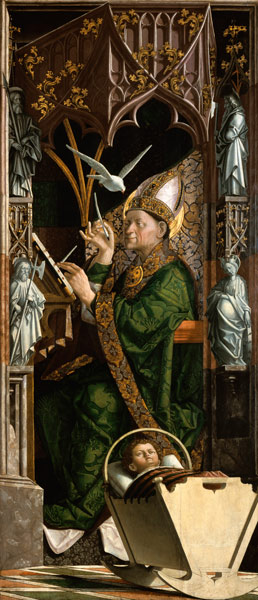
Michael Pacher was a painter and sculptor from Tyrol active during the second half of the fifteenth century. He was one of the earliest artists to introduce the principles of Renaissance painting into Germany. Pacher was a comprehensive artist with a broad range of sculpting, painting, and architecture skills producing works of complex wood and stone. He painted structures for altarpieces on a scale unparalleled in North European art.
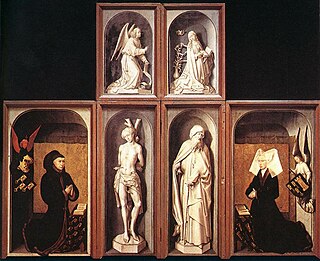
The Beaune Altarpiece is a large polyptych c. 1445–1450 altarpiece by the Early Netherlandish artist Rogier van der Weyden, painted in oil on oak panels with parts later transferred to canvas. It consists of fifteen paintings on nine panels, of which six are painted on both sides. Unusually for the period, it retains some of its original frames.

The Master of the Morrison Triptych is the name given to an unknown Early Netherlandish painter active in Antwerp around 1500-1510. He is named for the Morrison Triptych, now in Toledo, Ohio, United States, which is described below.

Jacques de Baerze was a Flemish sculptor in wood, two of whose major carved altarpieces survive in Dijon, now in France, then the capital of the Duchy of Burgundy.

The Donne Triptych is a hinged-triptych altarpiece by the Early Netherlandish painter Hans Memling. It consists of five individual panel paintings: a central inner panel, and two double-sided wings. It was painted for the soldier, courtier and diplomat Sir John Donne, probably sometime between the late 1470s or early 1480s, and contains portraits of Donne, his wife and daughter. It is kept in the collection of the National Gallery, London, with the panels still in their original frames.

The St John Altarpiece is a large oil-on-oak hinged-triptych altarpiece completed around 1479 by the Early Netherlandish master painter Hans Memling. It was commissioned in the mid-1470s in Bruges for the Old St. John's Hospital (Sint-Janshospitaal) during the building of a new apse. It is signed and dated 1479 on the original frame – its date of installation – and is today still at the hospital in the Memling museum.

The Annunciation is an oil painting by the Early Netherlandish painter Hans Memling. It depicts the Annunciation, the archangel Gabriel's announcement to the Virgin Mary that she would conceive and become the mother of Jesus, described in the Gospel of Luke. The painting was executed in the 1480s and was transferred to canvas from its original oak panel sometime after 1928; it is today held in the Robert Lehman collection of the Metropolitan Museum of Art in New York.

The Kefermarkt altarpiece is a richly decorated wooden altarpiece in the Late Gothic style in the parish church of Kefermarkt in Upper Austria. Commissioned by the knight Christoph von Zelking, it was completed around 1497. Saints Peter, Wolfgang and Christopher are depicted in the central section. The wing panels depict scenes from the life of Mary, and the altarpiece also has an intricate superstructure and two side figures of Saints George and Florian. The identity of its maker, known by the notname Master of the Kefermarkt Altarpiece, is unknown, but at least two skilled sculptors appear to have created the main statuary. Throughout the centuries, it has been altered and lost its original paint and gilding; a major restoration was undertaken in the 19th century under the direction of Adalbert Stifter. The altarpiece has been described as "one of the greatest achievements in late-medieval sculpture in the German-speaking area".

The Moreel Triptych is the name given to a 1484 panel painting by the Early Netherlandish painter Hans Memling. It was commissioned by the prominent Bruges politician, merchant and banker Willem Moreel and his wife Barbara van Vlaenderberch, née van Hertsvelde. It was intended as their epitaph at the chapel of the St. James's Church, Bruges, an extension they paid for, to the funerary church of Willem's family, where the couple intended to be interred in an underground tomb before the altar.

Adriaen van Overbeke, Adrian van Overbeck and Adriaen van Overbeke was a Flemish Renaissance painter in the style of Antwerp Mannerism. He operated a large workshop with an important output of altarpieces, which were mainly exported to Northern France, the Rhineland and Westphalia. His known works were predominantly polychromed wooden altarpieces with painted shutters, which were created through a collaboration between painters and sculptors.
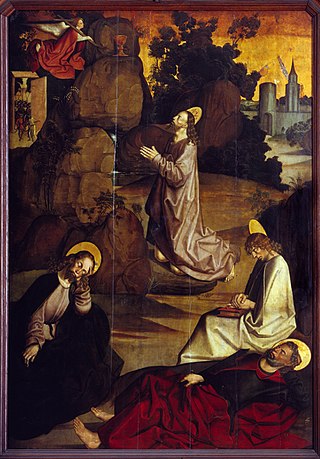
The Litoměřice Altarpiece (1505–1507) was a large altar retable, in all likelihood with two pairs of movable wings and two pairs of fixed ones. From these wings, six panels have survived, two of which are painted on both sides. The movable wings on the left-hand side of the altar are presumed lost. The altar wing depicting Christ on the Mount of Olives belongs to the Diocese of Litoměřice, while the other panels are owned by the Regional Museum in Litoměřice. It is the largest surviving set of panel paintings by an anonymous late Gothic and early Renaissance painter called the Master of the Litoměřice Altarpiece. The altarpiece is part of the permanent collection of the North Bohemian Gallery of Fine Art in Litoměřice.

St George's Altar is a large Gothic altarpiece from the 1460s-70s, originally placed in the St George's Convent at Prague Castle. It belongs to the property of the Metropolitan Chapter of St. Vitus and is on loan to the exhibition of medieval art of the National Gallery in Prague.
